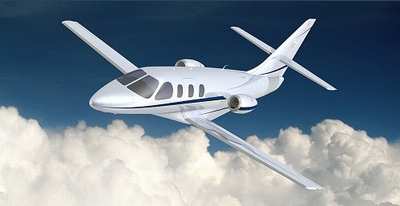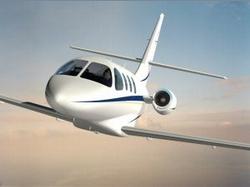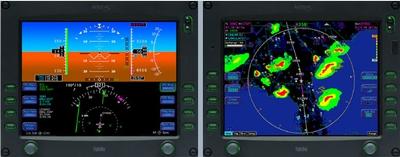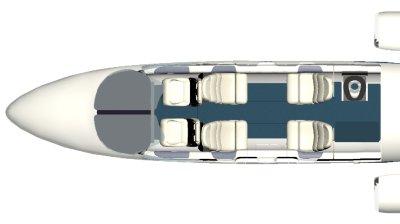S-26 Replaced With Larger Metal Aircraft
 Safire Aircraft has announced specifications and
details of its new personal jet. That means the original S-26
design (pictured below) will not be produced.
Safire Aircraft has announced specifications and
details of its new personal jet. That means the original S-26
design (pictured below) will not be produced.
CEO Camilo Salomon first announced that Safire moved from West
Palm Beach to Miami’s Opa Locka Airport on March 7, 2003, to
prepare for the development and flight-testing program. He said
city, county and state authorities have provided substantial
incentives to help launch the program.
A Better Deal?
“Opa Locka is an ideal location for development and
assembly of the prototypes," said Salomon. "The offices are
directly adjacent to 30,000 sq ft of hangar space where the
assembly of two flying and two static prototypes will soon begin.
Our offices open directly into the hangar area and offer the ideal
environment for the flight test program and certification of the
new Safire Jet. Everything is running smoothly towards first flight
early next year.” He added that hiring is now in high gear
and the Safire engineering team will exceed fifty by the end of
August - seventy by the end of 2003.

To speed up certification and allow a more flexible ramp up to
higher rates of production, Safire has decided to become a
“final assembly only” facility, rather than producing
components and subassemblies themselves. “The concept is to
share the risk and ramp up effort with a number of well-established
aviation suppliers. We are negotiating contracts for major
subassemblies with the most experienced and renowned companies in
the industry. Once all the parts and components are delivered to
us, we will begin assembling the first flying prototype.
Procurement is in full swing and contracts for the main components
of the aircraft have been signed,” said Salomon.
Salomon noted that the selection of the Williams FJ33-4 engine
announced last month came after many months of intensive
investigations with Williams, Pratt & Whitney and Honeywell.
“In the final analysis”, he stated, “it became
very clear that the FJ33-4 is the only engine sufficiently
developed to power the first generation of Safire Personal Jets.
Williams was able to modify their highly successful and proven FJ44
design and will provide an FAA-certified engine by the end of 2003
that will mate well with our improved Safire Jet design. With fully
certificated engines, Safire will achieve first flight in the first
quarter of 2004 and final certification by the end of 2005.
Deliveries will begin in early 2006.”
More Changes
 Salomon said the aircraft will now be made of
metal instead of composite fibers. “Safire’s engineers
began to explore alternatives last year, when it became obvious
that an ultra lightweight/low-cost engine was not available to meet
our schedule requirements. All other suitable engines weigh
approximately 300 pounds each and produce thrust of 1,100 pounds.
Thus, the aircraft’s structural weight had to be increased to
accommodate the added weight of the engines. With approximately 33%
more thrust, other changes were also required.”
Salomon said the aircraft will now be made of
metal instead of composite fibers. “Safire’s engineers
began to explore alternatives last year, when it became obvious
that an ultra lightweight/low-cost engine was not available to meet
our schedule requirements. All other suitable engines weigh
approximately 300 pounds each and produce thrust of 1,100 pounds.
Thus, the aircraft’s structural weight had to be increased to
accommodate the added weight of the engines. With approximately 33%
more thrust, other changes were also required.”
“We are very excited about the new Safire Jet, as we have
dubbed the new airplane," Salomon said in a release to ANN. "In
virtually every area of performance and size, these changes have
resulted in a faster, larger, more comfortable, longer-range
aircraft, with comparable direct operating costs. In fact, we still
have more thrust than is required and during testing could discover
that some of the performance improvements will possibly be better
than projected. One thing for sure, the new Safire Personal Jet
with the Williams FJ33-4 engines will have very zippy
performance.”
The most important advances are:
- 50-knot speed increase
- NBAA IFR range increase
- A larger cabin that permits, as standard equipment, an enclosed
aft lavatory with a hard partition.
 While incorporating these necessary design
changes, Salomon stated that Safire’s production and
certification personnel conducted extensive analyses of the
certification requirements for the original advanced composite
material airframe. Based on their findings, it was concluded that a
composite structure would yield no meaningful weight advantage and
that reverting to an all-aluminum structure, which utilized
conventional manufacturing techniques would significantly simplify
the certification process, as well as lower cost and time
requirements.
While incorporating these necessary design
changes, Salomon stated that Safire’s production and
certification personnel conducted extensive analyses of the
certification requirements for the original advanced composite
material airframe. Based on their findings, it was concluded that a
composite structure would yield no meaningful weight advantage and
that reverting to an all-aluminum structure, which utilized
conventional manufacturing techniques would significantly simplify
the certification process, as well as lower cost and time
requirements.
Another advantage of using proven techniques and materials is
that field support and maintenance would be substantially more cost
effective for all operators. “First flight of the new
aluminum design is now set for early 2004," said Salomon.
"Certification is expected by the end of 2005 and deliveries will
begin in early 2006. We are confident we will be first to
market.”
Avidyne Contract
Salomon then announced that Safire has signed a contract with
Avidyne to supply its FlightMax Entegra™ integrated flight
deck. “This will make every pilot’s dream of a
stateof-the-art-glass cockpit come true,” Salomon stated.
In addition to the avionics by Avidyne, Salomon announced that
the landing gear will be supplied by Castle Precision of Sylmar
California. He noted that contracts for approximately 80% of the
Safire Jet’s major assemblies and components have been
negotiated and will be announced as contracts are finalized.

The Money Thing
Salomon said, as a result of the significant improvements in the
Safire Personal Jet, the base target price of the new aircraft is
now as follows:
- All existing depositors will have access to the new aircraft at
a target price of $1,295,000 (Q2, 2003 price basis) and will keep
their original delivery position. No additional deposits will be
required from them until 10 hours of flight-testing are completed
with prototype.
- All new depositors will be offered a target price of $1,395,000
(Q2, 2003 price basis). They will be assigned delivery positions
subsequent to positions assigned to existing position holders.
- New depositors will be required an initial deposit of $20,000
and a second payment due after 10 hours of flight-testing.
Safire presently claims to have "in excess of" 720
deposits. Salomon noted that virtually all other personal jet
programs have experienced the same magnitude of growth and changes
that Safire announced Friday. “It reflects the status of the
engine technology that is available. With cutting of first metal in
the next several months, and being the only program that will
incorporate an engine that is certificated at first flight, we are
confident that we will be first to market, with the most dependable
engine, airframe and systems,” Salomon said.

Concerning competitors Salomon said, “We know that we are
developing a great new aircraft. It will outperform the $2.6
million dollar Cessna Mustang and will fly as fast and as high as
the seven seat, $3.9 million dollar Cessna Citation CJ1.
Surprisingly, even the four place seating arrangement of the Safire
Jet is essentially the same size as that of the CJ1. Nevertheless,
we are pleased to note that, at $ 1.295 million in 2003 dollars,
the preliminary target price of the new Safire Jet, will still be
three times lower than that of the Cessna CJ1 and its direct
operating costs will be substantially lower than those of the
CJ1."
Safire said it is evaluating different, low cost, lease and
financing options, with terms of up to twenty years, to be
optimized for the Safire Personal Jet. Safire is also preparing
packages including training and insurance for its buyers. A rollout
celebration is planned for early next year.
 ANN's Daily Aero-Linx (04.17.24)
ANN's Daily Aero-Linx (04.17.24) ANN's Daily Aero-Term (04.17.24): Jamming
ANN's Daily Aero-Term (04.17.24): Jamming ANN's Daily Aero-Linx (04.18.24)
ANN's Daily Aero-Linx (04.18.24) Aero-News: Quote of the Day (04.18.24)
Aero-News: Quote of the Day (04.18.24) ANN's Daily Aero-Term (04.18.24): Hold-In-Lieu Of Procedure Turn
ANN's Daily Aero-Term (04.18.24): Hold-In-Lieu Of Procedure Turn








